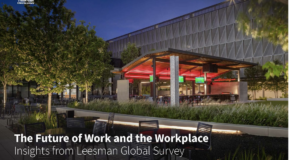
Edge architecture has paved the way to the digital future by moving compute right where the action is, harnessing the power of the data shed by IoT devices to create new architectures such as smart cities and buildings. As interesting as the underlying technology is for these platforms, what impact will they have on the day-to-day lives of people? One obvious area that will be impacted is the way humans work. As these technologies begin to mature, what impact will they have on the future of work?
Will Robots Take Our Jobs?
When speaking of the future of work, automation usually comes to mind. McKinsey reports that AI and automation “could account for as much as $3.5 trillion to $5.8 trillion in annual value, or 40 percent of the value created by all analytics techniques”, while at the same time saying that “about half of the activities (not jobs) carried out by workers could be automated."
Those are big numbers! If job tasks are automated and the machines are taught to think, will there be any work left for humans? It seems likely that there will be plenty of new jobs supporting the new edge architectures, IoT devices, and smart city and building architectures mentioned earlier. Technology changes always bring new jobs.
Additionally, the report discusses tasks that will be automated, not jobs. Allowing AI other automation to handle rote (often boring) tasks should help liberate most workers from doing mundane, repeatable tasks and will provide them the necessary time in their day to complete the types of higher-level tasks that require them to use their experience and judgment to make decisions.
Changing Models of Work
In addition to automation, or perhaps because of it, we have already seen the modalities of work change.
- Gig Economy: Usually driven by technology (especially mobile phones and apps), gig economy workers typically contract with a company to do piece work: delivering food, driving strangers to the airport, walking strangers’ dogs. They may do this to augment other work, but many earn enough at one gig job to completely support themselves. McKinsey describes the defining features of this type of independent work as “a high degree of autonomy; payment by task, assignment, or sales; and a short-term relationship between worker and client.”
- Remote Work: In 2018 in the US, about 16% of the US workforce worked at home in some fashion according to the US Bureau of Labor Statistics (we know that the number has gone up substantially). Remote work can mean many things: workers could work remote full or part-time, or work from a different branch location in the course of their duties.
As automation takes over the mundane tasks, and work tasks become more knowledge intense, it is becoming less important to be tethered to one location. This American Psychological Association article acknowledges that there are benefits to the workers as well as employers to embracing a "work where you are" mindset if socialization and communication challenges are addressed.
Technology is what makes these new models of work possible. The gig economy is dependent on an array of interconnected apps, smartphones, and a stable fast network to accept jobs, report that the work is completed, and accept payment.
Remote workers also depend on technology. Working from home requires the ability to securely access corporate networks, along with a reliable way to communicate via audio and video. Untethering your workforce to make entering your campus buildings, getting on your network, and even finding the best rooms in which to hold meetings can improve the creativity needed in most knowledge worker positions.
Real Talk
The Future of Work is here. The technology has finally caught up to the desire to work untethered from one physical location, and the improvements of automation should liberate us from rote, low-value work.




